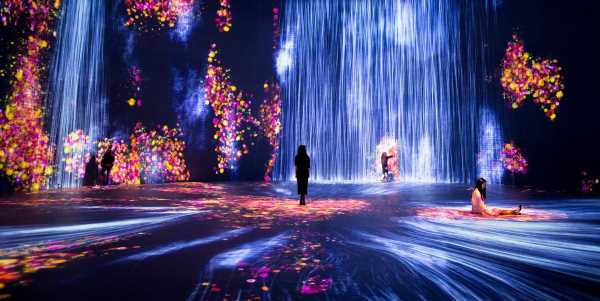
When Emily Cooper breezily bypassed the Louvre in favor of Atelier des Lumières’ digital reproduction of Starry Night on the Netflix series Emily in Paris, art lovers everywhere cringed from their couches. A room filled with digital renderings of famous artworks—oversize, animated, set to music, and sometimes even scented (quelle horreur)—hardly compares to the real thing. Or does it?
Already a fixture in Europe and Asia, digital art spaces are sprouting up across the U.S., promising immersive experiences that can transport viewers. The expansive, room-wrapping format of these shows riffs on an experience created by teamLab, an art collective based in Tokyo. In 2001, they debuted their landmark digital art technology, creating interactive rooms that grew into an eponymous museum in Tokyo, which opened in 2018. It had 2.3 million visitors its first year, the largest attendance for a single-artist institution in the world.
Load Error
Aside from one-off exhibitions like Yayoi Kusama’s Mirror Rooms or Random International’s Rain Room, the most established of these spaces in the U.S. is Artechouse in New York’s Chelsea Market (it also has outposts in Washington, D.C., and Miami Beach) which commissions digital artists to create specific digital installations. But it’s not the only game in town anymore: Superblue, opening this spring in Miami, is taking things up a level by including installations from teamLAB (as seen in the above main image) and James Turrell.
Museum curators are reckoning with the fact that these destinations, once dismissed as Instagram fodder, could also be the way forward in the world of classical art. Dwindling museum foot traffic is a real issue that was exacerbated by Covid-19 restrictions.
“People are introduced to and engage with art differently now,” says Jonathan Berger, marketing director at Newfields Museum in Indianapolis (formerly the Indianapolis Museum of Art).“As a cultural institution we have to reflect that, yet even though society has changed, museums haven’t.” The Newfields Museum is the first U.S. institution to go all-in on a dedicated space in hopes to increase visitors. It is dedicating its entire fourth floor to a 33,000-square-foot virtual space, entitled The Lume, which will open in June.
Other classical remixes include both traveling pop-up exhibitions, such as San Francisco’s“Immersive Van Gogh,” which opened March 18 after a residency in Toronto, and standalone venues. Culturespaces, the company behind Paris’s Atelier des Lumières of Emily in Paris fame, is opening an outpost in Lower Manhattan’s former Emigrant Industrial Savings Bank this spring (date to be announced). Coincidentally, all of these institutions are debuting with exhibitions of Van Gogh’s work.
“Anything that brings people to the fine arts is worthwhile,” says Steven Naifeh, curator and Pulitzer Prize-winning author of Van Gogh: The Life.“But at the same time, I think of it like music. As nice as listening to a recording can be, it would be terribly sad to never see a live performance.”
Undoubtedly, there is a poetry to standing next to a work of art, the same canvas that a great master touched, to study the brushwork; it just might not be enough alone to sustain the institutions these works call home. The staggering numbers drawn in by digital shows is a tempting lure, one that museums hope will get people in the door and then stick around to explore the collections IRL.
Van Gogh is a suitable entry to art, and not only because of his popularity. Van Gogh wanted as many people to see his work as possible and even painted duplicates of Sunflowers and Lullaby to send out to friends. If he were around today it is likely he would be impressed by these extravagant displays—and he might even tag himself.
Source: Read Full Article










